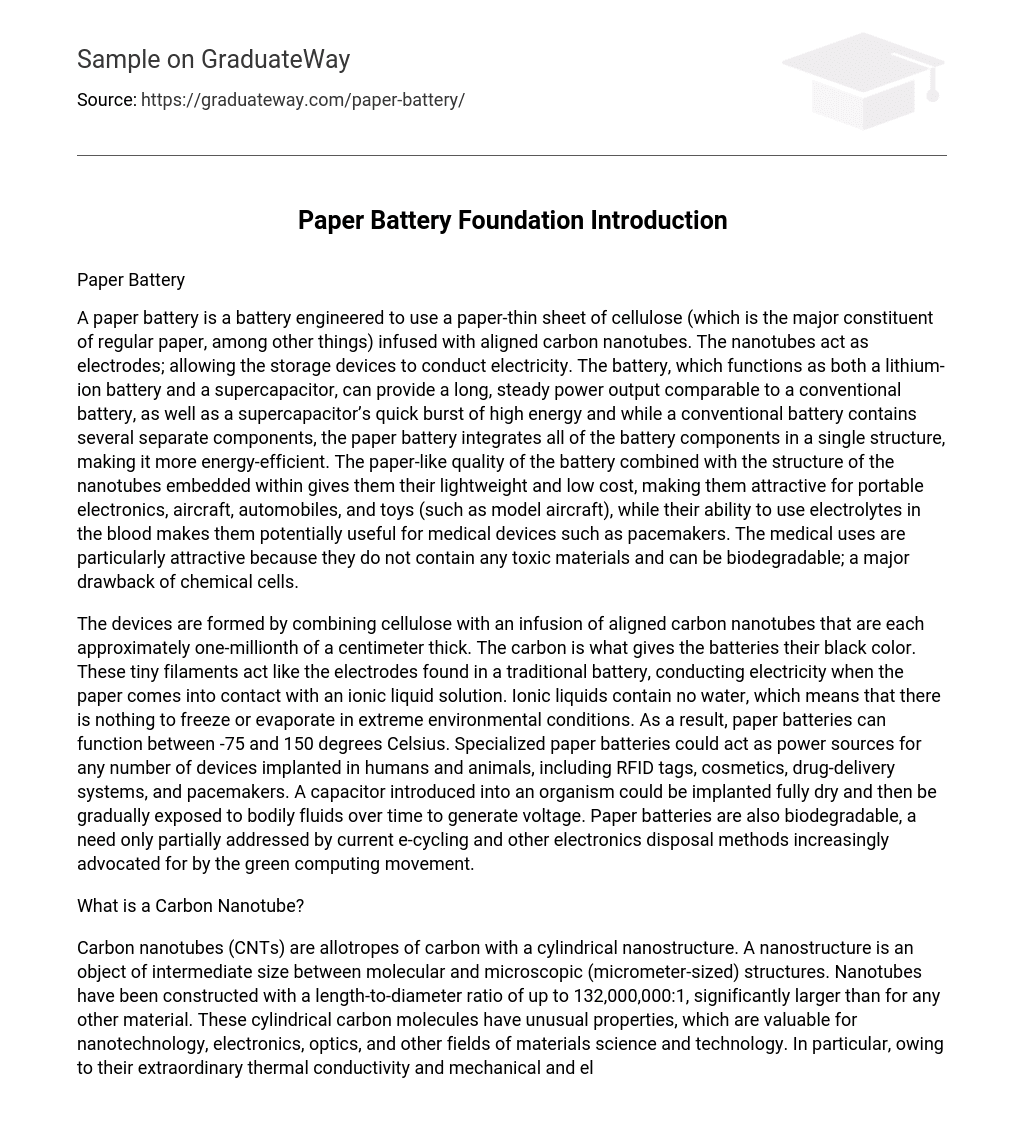Paper Battery
A unique type of battery, known as a paper battery, uses a thin sheet of cellulose infused with carbon nanotubes as electrodes. This allows for the flow of electricity. The innovation lies in the fact that this battery serves dual purposes: it functions both as a lithium-ion battery and a supercapacitor. As a result, it provides steady power output like traditional batteries while also delivering quick bursts of high energy akin to supercapacitors. Unlike regular batteries with separate components, the paper battery combines all its elements into one structure, resulting in improved energy efficiency.
The lightweight and affordable nature of this paper-like battery, along with its embedded nanotube design, make it suitable for various applications such as portable electronics, aircraft, automobiles, and model aircraft toys. Additionally, owing to its ability to utilize electrolytes in blood, it holds potential value for medical devices like pacemakers. Moreover, these batteries are appealing for medical purposes due to their lack of toxic materials and potential biodegradability—qualities that give them an edge over chemical cells.
The paper batteries utilize a combination of cellulose and aligned carbon nanotubes, which have an incredibly thin diameter of about one-millionth of a centimeter. The black coloration of these batteries is attributed to the presence of carbon. These tiny filaments serve as electrodes, similar to those found in conventional batteries. They conduct electricity upon contact with an ionic liquid solution, enabling them to function effectively. Unlike regular batteries, ionic liquids do not contain water, rendering them resistant to freezing or evaporation under extreme circumstances. Consequently, paper batteries can operate within a temperature range spanning from -75 degrees Celsius to 150 degrees Celsius. Such batteries possess considerable potential for use as power sources in various implants for humans and animals, including RFID tags, cosmetics, drug delivery systems, and pacemakers.
By gradually exposing a capacitor implanted within an organism’s body fluids, it can generate voltage during the transition from complete dryness. Additionally, paper batteries are environmentally friendly owing to their biodegradability—a quality that partly addresses the green computing movement’s emphasis on proper electronics disposal.
What is a Carbon Nanotube?
Carbon nanotubes (CNTs) are carbon-based cylindrical nanostructures with an impressive length-to-diameter ratio of up to 132,000,000:1. These distinctive carbon molecules exhibit remarkable thermal conductivity, mechanical strength, and electrical properties. Consequently, CNTs find applications in diverse fields such as nanotechnology, electronics, optics, and materials science. Moreover, they can be incorporated into structural materials like baseball bats, golf clubs, or car parts.
Nanotubes are part of the same structural family as buckyballs. They are long, hollow structures made of one-atom-thick sheets of carbon called graphene. A nanotube can have a hemisphere cap with a buckyball structure at its ends. The sheets are rolled at specific angles known as “chiral” angles. The combination of the rolling angle and radius determines the properties of the nanotube, such as whether it acts as a metal or semiconductor. Nanotubes are divided into single-walled nanotubes (SWNTs) and multi-walled nanotubes (MWNTs). Individual nanotubes naturally form ropes held together by van der Waals forces, specifically pi-stacking.
Development of Paper Batteries
The collaboration of various fields such as materials science, energy storage, and chemistry led to the development of a unique nanocomposite paper. In August 2007, Dr. Robert Linhardt and his team at Rensselaer Polytechnic Institute created the paper battery. The team consisted of Dr. Linhardt, a professor specializing in biocatalysis and metabolic engineering; Pulickel M. Ajayan, a materials science and engineering professor; Omkaram Nalamasu, a chemistry professor who also had an appointment in materials science and engineering; Victor Pushparaj, Shaijumon M. Manikoth, Ashavani Kumar, Saravanababu Murugesan were postdoctoral research associates on the project along with Lijie Ci serving as a research associate; and Robert Vajtai was the Laboratory Manager at Rensselaer Nanotechnology Center.
Scientists at Rensselaer Polytechnic Institute and MIT have devised a technique for fabricating paper batteries. The procedure entails cultivating nanotubes on a silicon substrate and filling the gaps with cellulose. Once dried, the substance is removed from the substrate, revealing one end of the nanotubes as an electrode. By combining two sheets with the cellulose sides facing inward, a supercapacitor is formed. The activation of this supercapacitor involves introducing an ionic liquid serving as an electrolyte. This liquid can consist of solutions containing salt such as human blood, sweat, or urine. Paper batteries possess a high cellulose content (over 90%) and do not incorporate harmful chemicals, rendering them biocompatible and environmentally friendly compared to conventional lithium-ion batteries commonly utilized in electronic devices and laptops.
The widespread commercial use of paper batteries relies on the development of cheaper manufacturing techniques for carbon nanotubes. However, various companies and organizations are actively working on developing paper batteries due to their potential applications in electronics, aerospace, hybrid vehicles, and medical science. In 2005, researchers in Singapore announced the creation of a paper battery powered by ionic solutions, alongside advancements made at RPI and MIT in 2007. NEC has also invested in research and development for paper batteries with the intention of using them in their electronic devices.
Construction
Here is a concise explanation. Construction can be comprehended through the following steps:
- Firstly, a common Xerox paper of desired shape and size is taken.
- Next, by conformal coating using a simple Mayer rod method, the specially formulated ink with suitable substrates (known as CNT ink) is spread over the paper sample.
- The strong capillary force in paper enables a high contacting surface area between the paper and nanotubes after the solvent is absorbed and dried out in an oven.
-
A thin lithium film is laminated over the exposed cellulose surface which completes our paper battery.
This paper battery is then connected to the aluminum current collectors which connect it to the external load. - The working of a paper battery is similar to an electrochemical battery except with the constructional differences.
Reference:
- http://university-help.blogspot.com/2012/10/paper-battery-seminar-report-pptpdf.html
- Paper Battery – Seminar Report, Topic, PPT, PDF, DOC, Presentation, Free Download university-help.blogspot.in. Powered by Blogger.http://university-help.blogspot.com/2012/10/paper-battery-seminar-report-pptpdf.html





